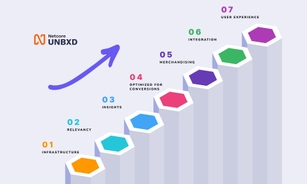- ProductsSearch and BrowseRecommendationsCustomer Engagement


The process of product discovery helps users to find the right product. This process involves finding the relevant products and ranking them in the correct order. This helps ecommerce businesses to adjust the order of the products and, consequently, optimize the customer's shopping experience for maximum revenue.
Shoppers not only look for relevant products but also consider the product's popularity and rating. In addition, they give importance to how other shoppers perceive the product and the feedback received from them. Shoppers would always want to buy the most popular product in any ecommerce store, and hence, for all practical reasons, online stores are always looking to promote the best-selling products.
Once this has been achieved, the ranking of the products becomes significant to the merchandiser. This is because they want to promote products with better profit margins or discounts to improve conversions. Ranking the relevant products according to their likelihood of purchase follows inextricably connected steps.
With the advent of artificial intelligence and machine learning, ecommerce businesses want to automate all such processes. Unfortunately, most AI products remain a black box to the user, with almost no control. However, they still seek out controls to optimize the functionalities and manage how the search engine ranks relevant products. Using the new Unbxd Ranking feature, merchandisers/analysts can optimize the ranking of products based on their business needs and use cases.
A merchandiser can also control these ranking controls through the merchandising options that Unbxd offers. A merchandiser can solve various business use cases using the merchandising section of the Unbxd console.
What are the different ranking scores and their controls?
Unbxd Search Ranking generates several scores to rank products for a query besides the relevancy scores. The scores are based on multiple signals like clickstream data, catalog data, user demographic data, seasonality, etc.
Unbxd combines these scores based on weightage to calculate an overall ranking score for each product in the retrieved set of products. The products are then sorted in descending order of that score to show the results for a query. Merchandising functions in the Unbxd Dashboard, such as boost and bury, are available to overwrite the computed scores and change the sort order of products.
With the new release of ranking controls, users could create different models of the various ranking scores. In addition, they could manage how products are ranked in the search results. For example, users can assign weights to different signals and control their relative importance in determining the score.
User behavior
User behavior score tries to rank products for a particular query based on clickstream data and catalog-based signals. The score looks at how shoppers have interacted with products for different queries. These signals affect the ranking of the query based on how significant the data is for that query.
Queries are broadly divided into 3 buckets based on their frequency:
-
Head Query – These are high-frequency queries that have significant clickstream data.
-
Torso Query – These are mid-frequency queries and have considerable clickstream data. Optimizations for these queries involve partially mapping these to their closest head queries and leveraging the head queries' clickstream data for optimization.
-
Tail Query – These are low-frequency queries with low or insignificant clickstream data. These queries heavily rely on Head Queries for optimization in their rankings.

By default, UB scores are generated for queries with significant clickstream data based on the last 30 days of clickstream data. The score generated is a function of clicks, carts, and orders for different periods.
As part of the User behavior score, users can create custom models where they can configure the following parameters:
-
Number of queries – The number of head queries for which scoring gets applied
-
The observation period for the clickstream data – The period of clickstream data used to train the model
-
Clickstream attributes – The user can add various clickstream attributes like click, cart, order, revenue, etc., and assign relative weights to them.
-
Catalog attributes – The user can add catalog attributes like scale, Clearance, New, Average Rating, and Discount% and assign weightage to them.

Once the model configuration is set, the model training kicks in, and the model will be ready within a couple of minutes. Once the model is ready, you can also preview the results of the model within the console.

Popularity
The popularity score of the product is related to the performance of every product across the site. Shoppers generally prefer to buy the best products in any store, and the popularity of the product is the best metric to gauge it. Thus, it makes the most sense to include popularity in the ranking score.
As part of the Popularity score, users can create custom models where they can configure the following parameters:
-
The observation period for the clickstream data – The period of clickstream data used to train the model
-
Clickstream attributes – The user can add various clickstream attributes like click, carts, order, revenue, etc., and assign relative weights to them
-
Catalog attributes – The user can add catalog attributes like scale, Clearance, New, Average Rating, and Discount% and assign weights to them.

Personalization
Personalization as a feature enables shoppers to create their own shopping journey. It helps ecommerce businesses present relevant products to shoppers, making the online shopping journey more efficient, enjoyable, and rewarding.
Unbxd uses a deep learning algorithm to provide personalized results to shoppers using various signals like catalog data, user data, demographics, clickstream data, seasonality, attribute affinity, etc. The model learns from automated signal detection and facilitates automated user profiling, segmentation, and user context understanding.
Users would have control over both the training and application of the model. The levers that would be exposed during model training are:
- Product attribute selection – the list of catalog attributes based on which the products would be personalized. This list of attributes would be used to measure the user's affinities.
- Clickstream attribute selection - The events based on which a product is personalized. The events can be clicks, carts, orders, or revenue.
- User attributes – Signals like location, device type, etc., can be used to train the model.
In addition to the above, users could decide how to apply the model and different strategies. They can use either of the following methods to rank products:
-
Boosting process – An additive boosting score would be assigned to each product
-
Re-rank strategy – the user would be able to re-rank the top ‘n’ products based on the personalization score

Freshness
Any new product added to the catalog faces the “Cold Start” problem. The problem arises because any new product never gains popularity as it would also be buried in the bottom and never have any clickstream data. The freshness feature helps new products gain a default boost for a particular period of time and, hence, gain initial popularity and clickstream data.
Users would be able to configure the following to control the score:
-
Freshness period – This is the period of time for which the extra additive boost would be applied and the period of time for which the product would be considered fresh
-
Decay Function – the degrading function based on which the score would reduce as time increases

How can ecommerce teams leverage the in-console controls?
Most search solutions in the market promise to fix the relevance issue for search queries, but no one talks about the how part of it. Merchandisers and ecommerce teams have no clue what happens at the backend to fix search relevance and ranking of relevant products.
Generally, the results are not impressive. Plus, they cannot control these relevance and ranking techniques and algorithms. Everything is like a black box to them.
We have had many instances where ecommerce stores came to us with similar challenges in the hope of finding an out-of-the-box solution. Unbxd ranking algorithms diligently score the relevant products for a search query so that the right products can be shown in descending order of popularity or likelihood of purchase.
However, I believe the most powerful thing about our technology and the product is its capability to leave enough control in the hands of merchandisers and ecommerce teams so that they are not left in the dark and make business decisions suited to their business needs.
If ranking and sorting the products are one of the pressing challenges you are facing to convert your shoppers to your online store, you should try the Unbxd Site Search.
